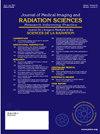核医学:Theranostics 之美
IF 2
Q3 RADIOLOGY, NUCLEAR MEDICINE & MEDICAL IMAGING
Journal of Medical Imaging and Radiation Sciences
Pub Date : 2024-10-01
DOI:10.1016/j.jmir.2024.101469
引用次数: 0
摘要
在过去二十年里,核医学领域取得了长足的进步,尤其是在治疗学领域。从根本上说,"Theranostics "一词由 "诊断 "和 "治疗 "两个词融合而成。其基本概念是 "我们看到什么,就治疗什么"。其原理是根据放射性同位素标记的选择和性质,使用相同分子结构的药物配体或类似物作为诊断或治疗药物。本讲座将主要介绍核医学领域的三个前沿创新课题:治疗前列腺癌(PCa)、神经内分泌肿瘤(NET)和肝细胞癌(HCC)的放射治疗技术。我们将通过讨论目前用于疾病评估和治疗的常用放射性同位素,探讨这些疾病的基本概念和应用。前列腺癌的放射治疗技术:我们将评估如何利用正电子发射断层扫描/计算机断层扫描(PET/CT)成像技术,通过注射18F-前列腺特异性膜抗原(PSMA)抑制剂来揭示PCa的PSMA过度表达。通过用镥-177(177Lu)替代放射性同位素,177Lu-PSMA 的β发射可将内放射线送达病变部位,同时保护周围正常组织:我们将讨论各种镓-68 (68Ga) 标记的 DOTA 肽(如 68Ga-DOTATOC 和 68Ga-DOTATATE)作为体生长激素类似物,以揭示 NET 的体生长激素受体 (SSTR) 表达情况。肝细胞癌的放射治疗:我们将探讨如何将锝-99m标记的大聚合白蛋白(99mTc-MAA)作为替代放射性示踪剂应用于SPECT/CT,以规划HCC患者的钇-90(90Y)微球放射栓塞治疗。在传统的 90Y 微球放射栓塞治疗方案中,推荐的固定剂量为 120Gy,而不是使用 CT 或 MRI 的物理参数,我们将深入探讨治疗前使用 11C 醋酸盐和 18F 氟脱氧葡萄糖的双示踪 PET/CT 在评估 HCC 细胞分化方面的意义,这些评估基于 HCC 的细胞因子特性和放射敏感性,有助于为患者量身定制 90Y 微球的剂量处方:核医学领域在治疗学方面取得了令人瞩目的发展。通过将诊断和治疗结合为一种单一的模式,可以实现更加个性化的治疗管理,并改善患者的治疗效果。本讲座概述了利用各种新型放射性同位素进行核医学治疗的概念和应用。本文章由计算机程序翻译,如有差异,请以英文原文为准。
Nuclear Medicine: The Beauty of Theranostics
The field of Nuclear Medicine had witnessed significant advancement in the past two decades, particularly within the area of theranostics. Basically, the term “Theranostics” is a fusion of two words – “Diagnostics” and “Therapeutics”. The backbone concept behind is “we see what we treat, and then we treat what we see”. The principle involves the use of a pharmaceutical ligand, either of the same molecular structure or an analogue, to serve either as a diagnostic or therapeutic agent based on the choice and nature of the labelling radio-isotope. This presentation will mainly cover three cutting-edge and innovative topics within the field of Nuclear Medicine: theranostics for prostatic carcinoma (PCa), neuroendocrine tumor (NET) and hepatocellular carcinoma (HCC). We will explore the basic concept and applications for these diseases by discussing the currently common used radio-isotopes for disease evaluation and therapy. Furthermore, we will discuss how to tailor make the pre-treatment imaging regime in order to personalize the treatment delivery and its potential impact on patient outcome.
Theranostics for Prostatic Carcinoma: We will assess how to utilize the positron emission tomography/computed tomography (PET/CT) imaging with injection of 18F-Prostate Specific Membrane Antigen (PSMA) inhibitor to reveal the PSMA overexpression of PCa. By replacing the radio-isotope with Lutetium-177 (177Lu), the beta emission of 177Lu-PSMA enables the delivery of internal radiation to the pathology while sparing the surrounding normal tissue.
Theranostics for Neuroendocrine Tumor: We will discuss various Gallium-68 (68Ga) labeled DOTA peptides (such as 68Ga-DOTATOC and 68Ga-DOTATATE) as somatostatin analogues to reveal the somatostatin receptor (SSTR) expression of NET. Additionally, we will review the treatment efficacy of 177Lu-DOTATATE in radionuclide therapy.
Theranostics for Hepatocellular Carcinoma: We will explore the application of Technetium-99m labeled Macroaggregated Albumin (99mTc-MAA) as a surrogate radiotracer in SPECT/CT for planning Yttrium-90 (90Y) microsphere radioembolization treatment in HCC patient. Instead of using physical parameters from CT or MRI as part of conventional 90Y-microsphere radioembolization treatment protocol, which is based on a recommended fixed dose of 120Gy, we will delve into the significance of pre-treatment Dual Tracer PET/CT using 11C-Acetate and 18F-Fluorodeoxyglucose, in evaluation of HCC cellular differentiation based on cytokinetic properties and radiosensitivities of HCC, which aids in tailoring the dosage prescription of 90Y-microsphere for individual patient.
Conclusion: The field of Nuclear Medicine has experienced a remarkable blossoming in the area of theranostics. By combing diagnostics and therapeutics into a single modality, it enables more individualized treatment management and provides improved patient outcome. This presentation has provided an overview of the concept and applications of theranostics in Nuclear Medicine with various novel radio-isotopes.
求助全文
通过发布文献求助,成功后即可免费获取论文全文。
去求助
来源期刊

Journal of Medical Imaging and Radiation Sciences
RADIOLOGY, NUCLEAR MEDICINE & MEDICAL IMAGING-
CiteScore
2.30
自引率
11.10%
发文量
231
审稿时长
53 days
期刊介绍:
Journal of Medical Imaging and Radiation Sciences is the official peer-reviewed journal of the Canadian Association of Medical Radiation Technologists. This journal is published four times a year and is circulated to approximately 11,000 medical radiation technologists, libraries and radiology departments throughout Canada, the United States and overseas. The Journal publishes articles on recent research, new technology and techniques, professional practices, technologists viewpoints as well as relevant book reviews.
 求助内容:
求助内容: 应助结果提醒方式:
应助结果提醒方式:


